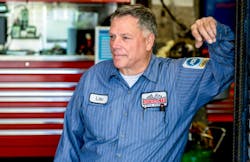SHOP STATS: Murante Auto Repair Location: Nazareth, Pa. Size: 2,500 square feet Number of Lifts: 5 Staff Size: 5 Average Monthly Car Count: 170 Annual revenue: $850,000
After 13 absent months, most people would assume the customer had moved on—a dissatisfied customer, displeased with the provided service, gone forever.
Then again, Lou Murante isn’t “most people.”
“I called [the customer] up,” says Murante, owner of Murante Auto Repair, “and said, ‘We’re updating our files, and I just want to make sure you’re still in the area, since we haven’t seen you in a year. Is there anything I can do for you?’”
“Actually,” the woman responds, “I was just thinking about you.”
After several unsuccessful visits to the area dealership, the woman was desperate to have the vibration in her brand-new vehicle diagnosed. Just a few days, one new axle and $1,700 later, Murante had not only obtained a new job, but had re-established this woman as a regular customer.
That level of customer care accounts for his Nazareth, Pa., shop’s 34 percent attrition rate—meaning, for every 100 customers, 76 of them are “active” and return visitors, while 34 choose another shop.
If that attrition rate sounds high to you, consider this: The participating shops in Murante’s 20 Group have crept above 50 percent, 60 percent, and even 70 percent—which included Murante five years ago. Improving customer retention involved several dramatic changes for the 38-year industry veteran, such as defining the right customers for growth, improving follow-up with customers, and retooling his shop’s projected brand.
The Backstory
Until 2012, Murante’s business approach hadn’t changed much since 1979 when he opened his shop in the small town of Nazareth, nudged between two corn fields and several dealerships and MSOs. That includes some occasional body work, which Murante focused on heavily when the shop originally opened.
“We only still do it because I enjoy it. I’m in a succession plan with my service advisor, and he will not continue with body work,” the 65-year-old says with a laugh. “This is just a ‘me’ thing I’ve continued to do because I enjoy it.”
That unshakable attachment to the “old” ways of doing business perfectly captures Murante. For years, he embodied the classic working-in-your-business mentality, involving himself in the repairs, the service writing, the accounting, the parts ordering. Financial stagnancy coincided with that schedule, with annual revenue sitting at just $300,000 in 2011.
And when the grind became too difficult for Murante five years ago, he was forced to evaluate what was holding his business back—which included lagging customer retention numbers.
The Problem
Murante didn’t religiously track attrition rates until it became a focus item at his monthly 20 Group meetings.
“For years, all we had discussed was best marketing practices,” Murante says. “And then you realize: You’re spending all our money on getting people in the shop, only to lose them.”
The average attrition rates in Murante’s group were bad—really bad. Everyone was investing in marketing and obtaining new customers—yet, on average, they were losing about 60 percent of those customers.
The culprit of high attrition rates varied from shop to shop, but Murante knew exactly why his sat around 50 percent: He had become disengaged with the customer on every level, and interactions with them had become more of a routine. He heavily focused on production, accounting, service writing, and repairing cars, meaning he rarely made time to improve the live customer experience and ensure people come back to the shop. But as customers aged and younger generations moved out of town, his detached daily routine revealed why he was losing customers.
The Solution
Murante’s revamped approach was built around one goal: Winning over the new economic order (NEO), an acronym signifying target customers.
A NEO—which Murante learned about after researching reports from social scientist Ross Honeywill—is socially active, believes in making high discretionary choices, and, most importantly for Murante Auto Repair’s turnaround, prefers quality over competitive pricing.
Murante, who competes with shops offering competitive prices, realized he had appealed to the opposite of NEOs for years: the traditionals, who have conservative social attitudes, spend reluctantly and invest only when necessary.
Murante’s multifaceted approach for improving his attrition rate branched from brainstorming sessions at his 20 Group and consultant meetings and included revamping the following:
The preferred customers. A high retention rate depends on one obvious factor, Murante says: Only certain customers are willing to invest in your business.
Murante realized altering prices to compete with area shops would not improve profits because the customer connection had been lost. That’s why he started to market his quality service and certifications, through both his traditional advertising methods (direct mailers and email newsletters) and his interactions with customers.
“Traditionals are about 55 percent of the population, but NEOs spend about 75 percent of the money,” Murante says. “And they’re responsible for almost 100 percent of the profit.”
“So if people weren’t invested in making responsible decisions for their cars,” he continues, “I don’t waste a lot of effort in trying to keep them as regular customers.”
The right service advisor. Murante wanted to ease out of service writing, which meant hiring a service advisor that carried the quality-over-price attitude. Luckily, he found Thomas, who not only bought into Murante’s approach and had a calm, approachable aura around customers, but also possessed deep technical expertise to boot.
The first impression. As Murante revamped the customer experience, the environment changed with it. Changes involved evaluating the shop layout and brainstorming new ideas with employees and his consultant. One of the best suggestions he received was cutting down a divider wall in the front of the shop and turning it into a counter for his service advisor.
He arranged his front office so that both Murante’s desk and his service advisor are in full sight to customers. That way, if either of them is busy, the other can greet the customer immediately. Murante even created an SOP for greeting both new and return customers.
“Even if we’re busy, we’re going to look up and acknowledge the customer,” he says. “We’ll put a finger up if we’re on the phone: ‘We’ll be right with you.’”
The follow-up. Murante likens losing customers to a conveyor belt.
“After the twelfth month, they fall off the belt and they're a lost customer and you don’t have them anymore,” he says. “Those are the ones I call.”
Seriously. One of Murante’s best strategies for improving attrition rates has been cold-calling customers. Through his consultant, he utilizes a program that informs him when a customer hasn’t returned for 12 months. Often, he just ends up conversing with the traditional customers—however, as noted at the beginning of the story, he wins back many people and creates new return visitors.
The Aftermath
Five years into his new approach, attrition rates are way down to 34 percent. So, out of 100 customers, roughly 15 have gone from lost business to loyal spenders.
On top of it all, his improved reputation has spread word-of-mouth, and he’s attracting more and more business from surrounding NEO customers. He’s increased staff and invested in upgrading his shop floor, leading to a $550,000 increase in annual revenue (it stands at $850,000 today).
The Takeaway
Focusing on customer retention has provided so many tangible improvements for the shop, but Murante continually addresses the most rewarding lesson he’s learned almost 40 years into his career.
“If you have a passion for the business, you’ll keep looking to do better. You never settle for traditional. You embrace new ideas and listen to others,” he says. “And that’s where I’m at—I’m really ready to jump to another level at this point.”
Expert Advice: Evaluating Customer Attrition Trends—
RLO Training/Bottom-Line Impact Group facilitator John Wafler has analyzed customer attrition rates recently, and has come up with some very interesting observations. Here, he details some of the factors at play and what shops need to focus on to improve their customer retention performance.
For many years, the auto repair industry has assumed average attrition rates in most independent shops at 20–25 percent. With better tracking systems implemented, we are actually measuring rates as high as 50–60 percent for many independent shops.
If you start the year with 1,000 “active” customers in your database, and you don’t add any new customers, you would end the year with 500–600 active customers. An average “active customer” spends about $800–$1,000 per year on service and repair. So, losing that many active customers is a significant threat to long-term business success and forces you to acquire more new customers just to maintain your customer base.
What we are also seeing is that almost 70 percent of all lost customers have less than four visits in total. After four visits, they are 70 percent more likely to remain active customers, so getting them to the fourth visit should be a key focus of your retention marketing.
Another alarming measurement is that over 50 percent of new customers never return for a second visit. Identifying new customers and putting a “focused” first-time customer retention strategy in place is a key to growing your active customer base. Also, effective marketing to attract the “right customer” for your shop significantly improves long-term retention rates and growth.
Many shop CRM programs rely too heavily on electronic communication. The problem is that shops aren’t consistently capturing customers’ email addresses, and less than 30 percent of sent emails are opened. In the Bottom-Line Impact Groups, many members are having better success with personalized customer follow-up programs like handwritten thank you or reminder cards and phone calls to communicate with their customers.

